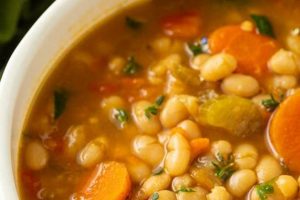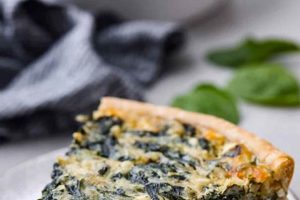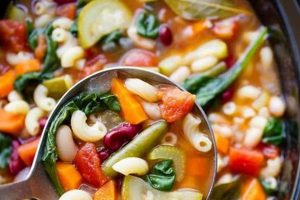Formulations aligning with both the Autoimmune Protocol (AIP) and vegan dietary frameworks represent a specialized category of culinary practices. These preparations exclude grains, legumes, nightshades, seeds, nuts, eggs, and dairy products, common restrictions in AIP diets, while also adhering to the vegan principle of abstaining from all animal-derived ingredients. A representative dish might feature coconut milk-based curries incorporating leafy greens and root vegetables.
This dietary approach offers potential benefits for individuals seeking to manage autoimmune conditions while adhering to plant-based eating. The restrictive nature aims to reduce inflammation and identify potential food sensitivities. Historically, the combination of AIP and vegan principles has emerged as individuals explore personalized nutrition strategies to address health concerns and ethical considerations related to animal welfare.
The subsequent sections will delve into specific ingredient substitutions, meal planning strategies, and considerations for ensuring nutritional adequacy within this unique dietary context. Practical guidance for adapting conventional dishes and navigating potential challenges will be provided.
The intersection of the Autoimmune Protocol and veganism presents unique challenges in food preparation. The following guidance facilitates successful implementation of this combined dietary approach.
Tip 1: Prioritize Root Vegetables: Sweet potatoes, taro root, and parsnips offer carbohydrate sources while complying with both AIP and vegan restrictions. Incorporate these as staples in meal planning.
Tip 2: Utilize Coconut Products: Coconut milk, oil, and flakes provide fats and flavor often derived from excluded sources. Ensure that the coconut products are free from added sugars or stabilizers to adhere strictly to AIP.
Tip 3: Incorporate Leafy Greens Extensively: Kale, spinach, and collard greens are nutrient-dense and versatile. Steam, saut, or blend them into smoothies to maximize intake.
Tip 4: Experiment with AIP-Compliant Flours: Tigernut flour and tapioca starch can be used in moderation for baking or thickening sauces. Consider the impact on blood sugar levels and overall nutritional profile.
Tip 5: Focus on Broths and Soups: Bone broth is typically excluded, therefore vegetable broths prepared with AIP-compliant vegetables provide hydration and valuable minerals. Add seaweed for enhanced mineral content.
Tip 6: Fermented Foods, with Caution: While not strictly prohibited, fermented foods like sauerkraut should be introduced carefully to assess individual tolerance. The impact on histamine levels should be considered, as they may exacerbate symptoms for some individuals.
Tip 7: Source High-Quality Fats: Avocado and olive oil are acceptable fat sources. Ensure they are unrefined and used appropriately for cooking temperatures to avoid oxidation.
The outlined strategies support the successful integration of autoimmune protocol and vegan principles in food preparation. This methodology enhances dietary diversity and nutritional completeness while adhering to necessary restrictions.
The subsequent section will discuss methods for adjusting standard vegan fare to comply with AIP protocols.
1. Ingredient Substitutions
Ingredient substitutions are a cornerstone of preparing formulations that meet both Autoimmune Protocol (AIP) and vegan dietary restrictions. The stringent limitations imposed by both frameworks necessitate strategic replacements of commonly used ingredients. For instance, the exclusion of eggs, a frequent binding agent in vegan baking, demands alternatives like gelatin-free agar-agar or apple sauce. Similarly, nightshades, such as tomatoes and peppers, which contribute significantly to many vegan dishes, necessitate the utilization of beet juice or butternut squash puree to achieve similar flavor profiles. The direct effect of these substitutions is the creation of meals that are both anti-inflammatory and plant-based.
The significance of ingredient substitution within the context of AIP vegan formulations extends beyond mere adherence to dietary guidelines. It involves a nuanced understanding of food chemistry and the functional properties of various ingredients. Consider the replacement of legumes, a staple in vegan diets, with ingredients like coconut aminos for soy sauce or green banana flour in baking. These substitutions not only maintain the nutritional integrity of the dish but also contribute to its overall palatability and texture. The substitution process often involves trial and error to achieve the desired result, making the role of a knowledgeable recipe developer crucial.
Effective ingredient substitutions are vital for the long-term viability and accessibility of AIP vegan dietary practices. While restrictive in nature, a diverse range of substitute options ensures culinary variety and promotes adherence. The ability to adapt familiar recipes to meet dietary needs empowers individuals to maintain a balanced and sustainable approach to both health and ethical eating. Without skillful substitution, an AIP vegan diet would be severely limited, leading to potential nutritional deficiencies and decreased quality of life. Therefore, a thorough understanding and application of ingredient substitutions are indispensable to achieving a satisfying and health-promoting AIP vegan diet.
2. Nutritional Adequacy
Achieving nutritional adequacy within the constraints of formulations adhering to both Autoimmune Protocol (AIP) and vegan dietary guidelines is a critical consideration. The combined restrictions limit the intake of numerous nutrients, necessitating careful planning to prevent deficiencies.
- Protein Sourcing
Traditional vegan protein sources, such as legumes and grains, are excluded in AIP. Consequently, individuals must rely on alternative sources, including leafy greens, certain vegetables, and limited quantities of AIP-compliant protein powders (derived from ingredients like pumpkin seeds, if tolerated). The absence of complete protein sources necessitates strategic food combining to ensure intake of all essential amino acids.
- Micronutrient Deficiencies
The elimination of nightshades, seeds, and nuts increases the risk of micronutrient deficiencies, particularly vitamins A, C, and certain B vitamins, as well as minerals like iron and zinc. To counter this, a focus on nutrient-dense vegetables, such as sweet potatoes and squash (for Vitamin A), and careful supplementation may be necessary. Regular monitoring of nutrient levels via blood tests is advisable.
- Fat Intake and Omega-3 Fatty Acids
While avocados and coconut products provide fats, ensuring adequate omega-3 fatty acid intake can be challenging. Flax and chia seeds, common vegan sources, are prohibited. Therefore, consideration should be given to algae-based omega-3 supplements to meet recommended daily intakes. Monitoring the ratio of omega-6 to omega-3 fatty acids is crucial for mitigating inflammation.
- Calcium and Vitamin D
Dairy alternatives are typically fortified with calcium and vitamin D, but these are excluded in this dietary approach. Individuals must consume sufficient quantities of calcium-rich vegetables, such as kale and collard greens, and ensure adequate sun exposure or supplement with vitamin D3 to maintain bone health. Careful attention to calcium absorption enhancers, such as vitamin K2, is also warranted.
The multifaceted nature of achieving nutritional adequacy underscores the complexity of implementing autoimmune protocol formulations within a vegan framework. Without meticulous planning and ongoing evaluation, individuals risk compromising their health. Consultation with a registered dietitian or nutritionist experienced in both AIP and vegan diets is highly recommended to optimize nutrient intake and minimize potential deficiencies.
3. Meal Planning Strategies
Effective meal planning serves as a cornerstone for successful adherence to formulations adhering to both Autoimmune Protocol (AIP) and vegan dietary principles. The highly restrictive nature of this combined approach necessitates meticulous planning to ensure nutritional adequacy, dietary compliance, and culinary satisfaction. Failure to implement structured meal planning often results in dietary non-compliance, nutrient deficiencies, and ultimately, a diminished quality of life. For example, the absence of pre-planned, AIP-compliant vegan lunches increases the likelihood of resorting to non-compliant processed foods when time is constrained. The cause-and-effect relationship highlights the critical role of strategic planning in the consistent implementation of this dietary regimen.
A practical example of the importance of meal planning lies in the strategic allocation of time for food preparation. Individuals following an AIP vegan diet typically require more time for ingredient sourcing and meal preparation compared to those adhering to less restrictive diets. Therefore, dedicating specific time slots for batch cooking or advance preparation of components, such as roasted vegetables or broth, streamlines the daily meal preparation process. Detailed planning also facilitates the identification of potential nutritional gaps. For instance, if a weekly meal plan lacks sufficient sources of calcium, adjustments can be made to incorporate calcium-rich vegetables or consider supplementation, guided by a healthcare professional. The integration of online resources and recipe databases can be particularly useful for discovering new formulations and strategies for maintaining dietary variety.
In conclusion, meal planning strategies are integral to the successful implementation of autoimmune protocol vegan practices. A structured approach enables consistent adherence to dietary restrictions, mitigates the risk of nutritional deficiencies, and promotes culinary enjoyment. While the initial investment of time and effort may be substantial, the long-term benefits of improved health and well-being make meticulous meal planning an indispensable component of the AIP vegan approach. Challenges in meal planning, such as time constraints or limited recipe knowledge, can be addressed through proactive resource utilization and engagement with experienced healthcare professionals.
4. Flavor Enhancement
The deliberate enhancement of flavor profiles within formulations compliant with both Autoimmune Protocol (AIP) and vegan dietary guidelines presents a significant culinary challenge. The elimination of traditional flavor enhancers, such as nightshades, seeds, nuts, and many spices, necessitates innovative approaches to achieve palatable and satisfying dishes.
- Herb and Spice Substitutions
The absence of common spices like black pepper, chili powder, and cumin necessitates the strategic employment of AIP-compliant alternatives. Herbs such as basil, oregano, thyme, and rosemary become essential, providing aromatic depth. The use of fresh herbs, when available, maximizes flavor intensity. Careful experimentation with less common herbs, like lemon balm or mint, can introduce novel flavor dimensions. The successful substitution of spices requires a thorough understanding of their individual flavor profiles and appropriate application within recipes.
- Acidic Components
Acidic components, such as lemon juice, apple cider vinegar, and coconut aminos, play a crucial role in balancing flavors and enhancing the perception of savory dishes. These ingredients provide brightness and complexity, counteracting the potential blandness resulting from dietary restrictions. The addition of acidic elements also contributes to the perceived intensity of other flavors, enhancing the overall sensory experience. Precise measurement and careful incorporation are essential to avoid overpowering the dish.
- Umami Enhancement
Umami, the savory taste often associated with glutamate, can be challenging to achieve in AIP vegan formulations due to the exclusion of soy sauce, mushrooms (for some individuals), and nutritional yeast. Alternatives include using seaweed (such as kelp or dulse flakes) to impart a subtle umami note, or slow-cooking vegetables to concentrate their natural sugars and savory compounds. Incorporating fermented foods, if tolerated and deemed AIP-compliant, like sauerkraut, can also contribute to umami.
- Textural Contrast
While not directly related to taste, textural contrast significantly influences the overall sensory experience of a dish. Introducing elements of crunch or chewiness, through ingredients like shredded coconut or well-cooked root vegetables, provides a more satisfying and engaging eating experience. The incorporation of varied textures can compensate for the absence of familiar ingredients and enhance the perceived flavor complexity.
The strategic application of these flavor enhancement techniques is crucial for creating culinary formulations that are both AIP and vegan compliant, while remaining enjoyable and satisfying. Continuous experimentation and refinement of recipes are essential to optimizing flavor profiles and ensuring long-term adherence to this restrictive yet potentially beneficial dietary approach.
5. Recipe Adaptation
The necessity of recipe adaptation is fundamental to the successful implementation of dietary protocols combining Autoimmune Protocol (AIP) and vegan principles. Standard recipes, whether vegan or omnivorous, often contain ingredients excluded by AIP, such as nightshades (tomatoes, peppers), seeds, nuts, eggs, and specific spices. Therefore, converting existing formulations to align with both AIP and vegan requirements mandates strategic ingredient substitutions and procedural modifications. The absence of proper recipe adaptation directly results in non-compliance, potentially negating the intended health benefits of the diet. Consider, for instance, a standard vegan chili. It typically includes tomatoes, beans, and chili powder – all prohibited on AIP. Adapting this recipe requires replacing tomatoes with beet puree for color and sweetness, omitting beans entirely, and substituting AIP-compliant herbs and spices for chili powder. The effectiveness of this adaptation determines the chilis suitability for an individual following the combined dietary restrictions.
Recipe adaptation within the context of AIP vegan diets goes beyond simple substitution. It often entails a comprehensive re-evaluation of the recipe’s structure and flavor profile. A standard vegan quiche, reliant on tofu and nutritional yeast for its eggy texture and flavor, requires complete reformulation. Tofu, a soy-based product, is not permitted on AIP, and nutritional yeast, while vegan, may trigger reactions in some individuals with autoimmune conditions. An adapted version might utilize a base of coconut milk and gelatin-free agar-agar to mimic the texture of eggs, with flavor derived from herbs and root vegetables. This process demands a thorough understanding of food chemistry and the functional properties of various ingredients. Success in adapting formulations relies on the accurate replication of texture, flavor, and nutritional content, all within the confines of AIP and vegan guidelines.
In conclusion, recipe adaptation is not merely a desirable skill but an essential component for individuals adhering to both AIP and vegan dietary protocols. This process enables the transformation of conventional recipes into formulations that meet specific dietary needs and preferences. The ability to adapt is crucial for maintaining dietary variety, ensuring nutritional adequacy, and sustaining long-term adherence to the combined dietary approach. Challenges in recipe adaptation, such as limited ingredient availability or lack of culinary expertise, can be mitigated through access to specialized resources and collaboration with experienced nutrition professionals. The significance of recipe adaptation underscores its role as a foundational element within the AIP vegan landscape.
Frequently Asked Questions
This section addresses common inquiries and misconceptions surrounding the intersection of Autoimmune Protocol (AIP) and vegan dietary practices. The information provided aims to clarify key aspects and offer practical guidance.
Question 1: Is it feasible to maintain adequate nutrient intake on a diet adhering to both AIP and vegan guidelines?
Nutritional adequacy presents a significant challenge. Meticulous meal planning, strategic ingredient selection, and potentially, targeted supplementation are necessary to address potential deficiencies in protein, iron, vitamin B12, calcium, vitamin D, and omega-3 fatty acids. Consultation with a registered dietitian or nutritionist is strongly recommended.
Question 2: What are acceptable protein sources within AIP vegan restrictions?
Traditional vegan protein sources such as legumes, grains, and soy are excluded. Acceptable options include certain vegetables (leafy greens, broccoli), limited quantities of AIP-compliant protein powders (derived from ingredients like pumpkin seeds, if tolerated), and strategic food combining to ensure intake of all essential amino acids.
Question 3: How does one address the lack of flavor when nightshades and common spices are omitted?
Flavor enhancement requires strategic use of herbs (basil, oregano, thyme), acidic components (lemon juice, apple cider vinegar), and umami-rich ingredients (seaweed). Textural contrast can also enhance the sensory experience. Experimentation and careful blending of flavors are essential.
Question 4: What are the primary considerations when adapting conventional vegan recipes to comply with AIP?
The most significant considerations are eliminating nightshades, seeds, nuts, and eggs. Careful substitutions are needed to maintain texture, flavor, and nutritional value. This often involves a complete re-evaluation of the recipe’s structure and ingredient ratios.
Question 5: Are fermented foods permitted within an AIP vegan protocol?
Fermented foods, while potentially beneficial for gut health, should be introduced cautiously. Individuals need to assess their tolerance, as fermented foods can sometimes exacerbate symptoms due to their histamine content. Ensure the fermented food is derived from AIP-compliant ingredients.
Question 6: What are some common pitfalls to avoid when following AIP vegan recipes?
Common pitfalls include inadequate meal planning, insufficient protein intake, failure to address micronutrient deficiencies, over-reliance on processed AIP-compliant foods, and neglecting to monitor individual tolerance to specific ingredients. Regular monitoring of health status and dietary adjustments are essential.
In summary, navigating AIP vegan formulations requires diligent attention to detail, a thorough understanding of nutrition, and a commitment to continuous learning and adaptation. The potential benefits of this dietary approach warrant the effort, provided it is implemented responsibly and under appropriate guidance.
The subsequent section will explore sample meal plans and recipe ideas to facilitate the practical application of AIP vegan principles.
Concluding Remarks on Autoimmune Protocol Vegan Formulations
The preceding sections have explored the intricate landscape of formulations adhering to both Autoimmune Protocol and vegan principles. The analysis underscores the inherent complexities in achieving nutritional adequacy and maintaining dietary compliance. The necessity of strategic ingredient substitutions, meticulous meal planning, and proactive flavor enhancement techniques is paramount. Individuals undertaking this combined dietary approach should remain cognizant of the potential challenges and actively seek guidance from qualified healthcare professionals. Recipe adaptation is not merely a supplemental skill but a foundational requirement for sustained adherence and culinary satisfaction.
The long-term viability and efficacy of autoimmune protocol vegan dietary practices hinge upon ongoing research and refinement of culinary strategies. Continued investigation into optimal nutrient sourcing and personalized dietary modifications is crucial for maximizing potential health benefits and mitigating risks. A comprehensive understanding of individual needs and tolerances, coupled with rigorous adherence to established guidelines, represents the pathway toward successful integration of these dietary frameworks. The pursuit of knowledge and the application of evidence-based practices are essential for navigating this complex nutritional domain.







